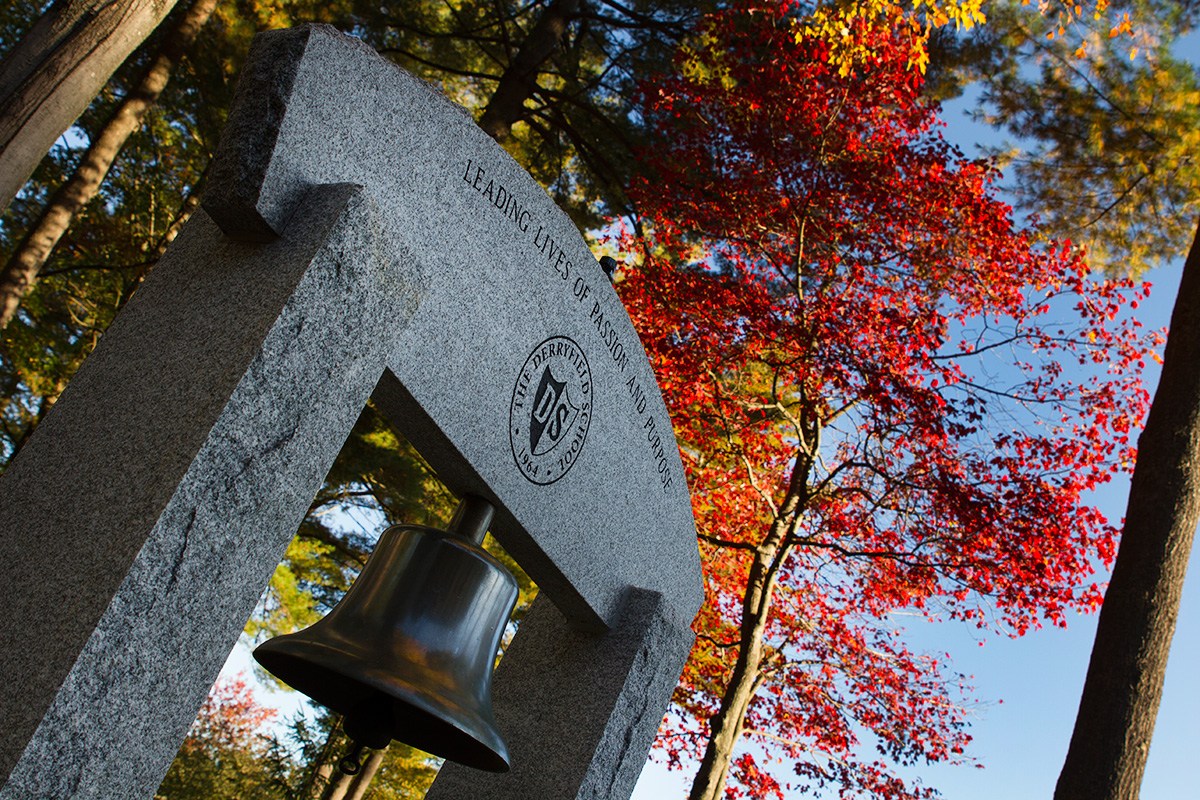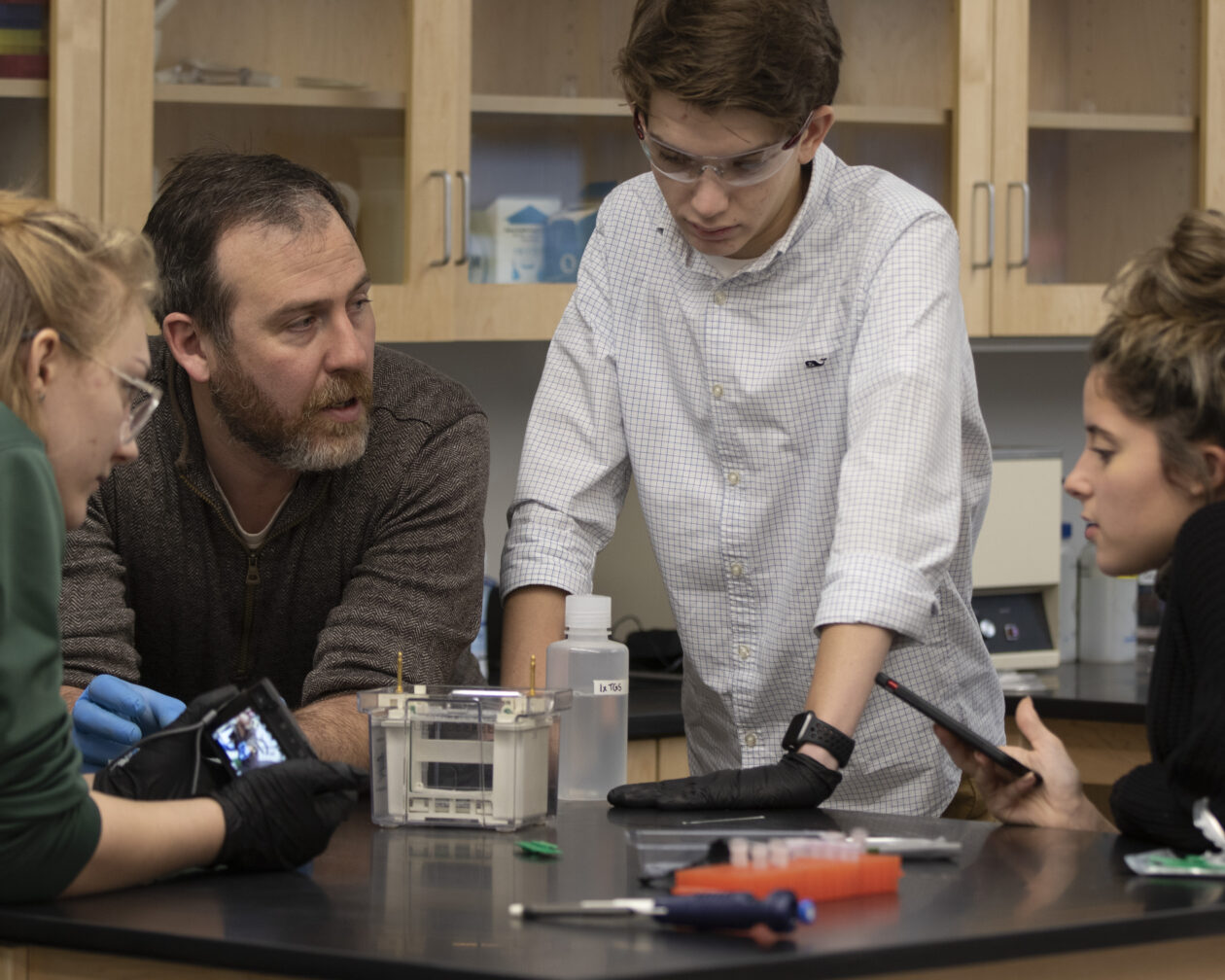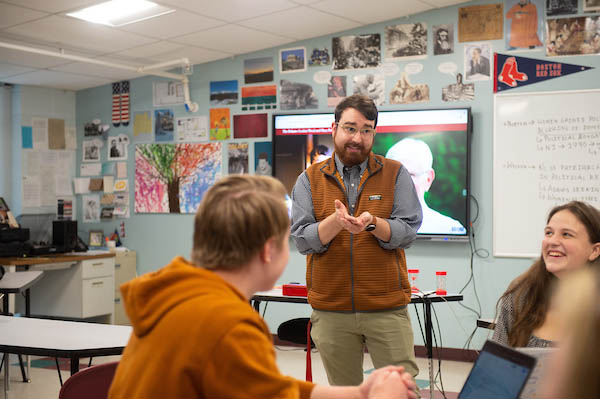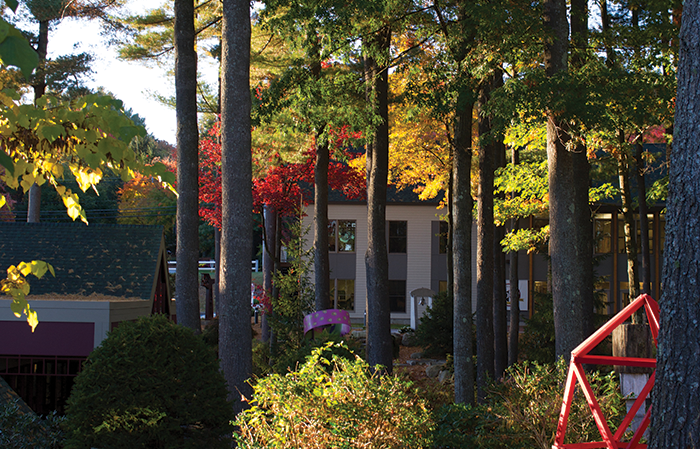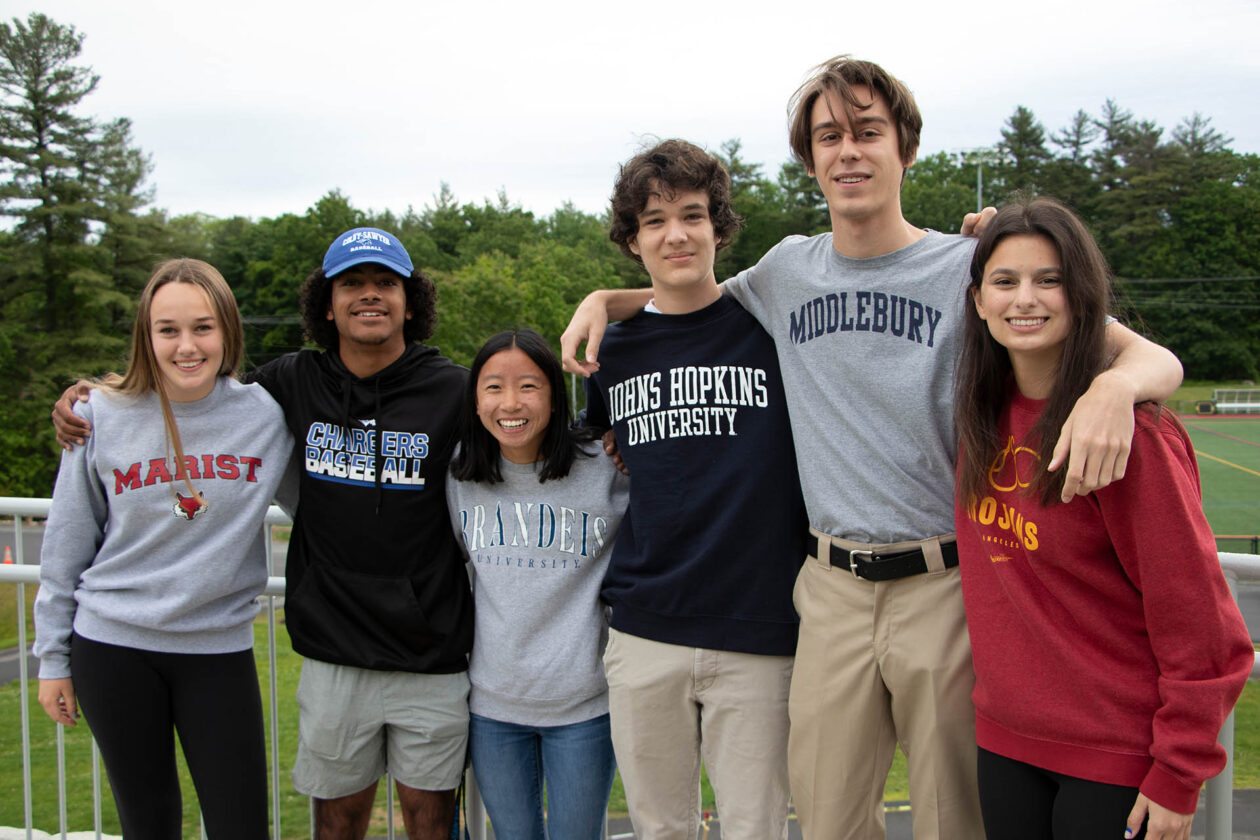Upper School STEAM
The Philosophy
The STEAM program introduces students to Design Thinking models that leverage Science, Technology, Engineering, Art and Mathematics (“STEAM”) to solve authentic problems. In a STEAM course, students engage in hands-on design work as they tackle challenges and tasks. Whether it’s designing software, designing an investment tool, building a robot, or experimenting with wing design, by challenging students to explore the unknown, we aim to ignite student creativity and empower them to answer important world questions.
STEAM: Engineering Design Process (F, S)
Open to: Grades 9-12
How are products developed? Why is there a new iPhone every year? What requirements need to be satisfied before an idea becomes a reality? In this course, students will be introduced to the iterative nature of the Engineering Design Process and work through it on a variety of projects. Using foundational engineering principles and hands-on practices, students will brainstorm, design, prototype, and develop solutions to real-world engineering problems. Students will engage with Derryfield’s portrait standards of critical thinking, collaboration, and problem solving as they work through projects including topics such as impact reduction, rocketry, energy conservation, and industrial engineering. This course is cross-listed with the Mathematics and Science Departments.
STEAM: Engineering Alternative Energy (F)
Open to: Grades 9-12
What is the future of energy? As humanity seeks to reduce greenhouse gas emissions and limit climate change, innovation in sources of renewable energy such as wind, hydro, solar, and nuclear will be vital. In this course, we will explore the current state of these energy sources as well as promising new technologies. Students will engage with Derryfield’s portrait standards of critical thinking, problem solving, and research as they analyze various alternative energy solutions and work to determine the appropriate implementation of these new technologies. While we won’t be able to build our own nuclear reactor, engineering projects may include building mini wind turbines, hydroelectric generators, and solar-powered cars. This course is cross-listed with the Mathematics and Science Departments.
STEAM: 3D Design (W)
Open to: Grades 9-12
Bring your ideas to life! In this course, students will be introduced to the fundamentals of 3D computer design and utilize the shapes-based modeling software TinkerCAD to push the limits of their creativity and technical understanding. Students will utilize Derryfield’s state-of-the-art makerspace to 3D print designs and construct final projects to satisfy specific criteria. Students will engage with Derryfield’s portrait standards of critical thinking, problem solving, and creativity to come up with unique designs that solve specific problems. They will design useful tools and unique decorations as they first explore the tools of TinkerCAD and work with the 3D printers. As the term progresses, they will be challenged to design more complex projects with moving parts and specific criteria. Their term will end with a self-driven project in which students will identify their own problem and utilize 3D design to solve it. This course is cross-listed with the Mathematics and Science Departments.
STEAM: Construction and Architecture (W)
Open to: Grades 9-12
In this course, students will be introduced to components of architecture and the various periods of architecture that have defined major construction projects through history. They will then apply this understanding to residential construction as they discuss various home styles and the characteristics that define them, including tours of Manchester’s own Frank Lloyd Wright homes. Students will engage with Derryfield’s portrait standards of problem solving, research, and creativity, as well as the science department standard of structure and function as they analyze, design, and develop homes and other structures. The term will culminate with students learning how houses are framed and constructed as they work to design and construct their very own model home up to code. This course is cross-listed with the Mathematics and Science Departments.
STEAM: Landscape Design (S)
Open to: Grades 9-12
In this course, students will study various landscaping features, how they are implemented, and their typical uses. Students will engage in the Derryfield portrait standards of critical thinking, problem solving, and critical thinking as they work through a variety of different projects. A complex inquiry into the importance of balancing form and function in design will be explored as well as the economic and environmental feasibility of certain features in various climates. Students will also explore the commercial applications of landscape design as they work to design their own golf hole, utilizing many of the features discussed in class. They will then work as a group to bring their ideas to life with a community-accessible miniature golf hole that will be built upon in future years. This course is cross-listed with the Mathematics and Science Departments.
Computer Science: Practice and Principles
Open to: Grade 9
This exposure course is designed to give all freshmen an introduction to the principles of computer programming and the impact that computational technologies have on modern society. We will work in the Python programming language and learn basic control structures and object manipulation as well as be introduced to data structures. We will also consider other topics such as cryptography and security, big data, digital humanism, virtual/alternate reality and artificial intelligence. Students will be able to transfer and apply the knowledge from this course to make better informed decisions about how to leverage technology using interdisciplinary approaches. Computer Science Practice and Principles also serves as a gateway to future coding and STEAM courses. This course is graded pass/fail and is included in LEAD programming. It is not open for separate course requests.
Computer Science: Web Development (F, W, S)
Open to: Grades 9-12
In this section of the Computer Science STEAM course, students learn how to create and stylize web pages using HTML and CSS. Students also have the opportunity to create interactive web applications using Javascript. This course is taught in a hands-on, laboratory format. Students begin the term by building small example web pages. Students then progress to designing and building their own custom website or application. The goal of this class is for the students to learn in a fun, non-intimidating way through self-paced, student-driven projects. If you’ve ever wanted to build your own beautifully stylized website, then this course is for you! This course is cross-listed with the Mathematics and Science Departments.
Computer Science: Programming with Arduino (F, W, S)
Open to: Grades 9-12
In this section of the Computer Science course, students learn how to build electronic circuits and control them using the popular Arduino microcontroller. Students learn about electricity and how to build useful systems that use sensors, motors, LEDs, buzzers, and touchscreens. Students also learn basic programming concepts and learn how to control electromechanical systems using an Arduino controller. This course is taught in a hands-on, laboratory format. Students begin the term by building example circuits and systems. Students then progress to designing and building their own custom invention. The goal of this class is for the students to learn in a fun, non-intimidating way through self-paced, student-driven projects. If you’ve ever wanted to create the next must-have electronic gadget, then this course is for you! This course is cross-listed with the Mathematics and Science Departments.
Computer Science: Mobile Application Design (F, W, S)
Open to: Grades 9-12
In this section of the Computer Science STEAM course, students learn to write mobile applications using the MIT App Inventor programming tool. Students learn basic programming concepts while they create fun, multimedia games and applications for an Android tablet or mobile phone. Students learn about event-driven programming, and they get practical experience in app design and development. This course is taught in a hands-on, laboratory format. Students begin the term by building instructive, example Android applications. Students then progress to designing and building their own custom application. If you’ve ever wanted to write the next viral app, then this course is for you! This course is cross-listed with the Mathematics and Science Departments.
Software Design with Java (Year Long)
Open to: Grades 9-12
This course offers an extensive introduction to computer programming and software design using the Java programming language. There are no prerequisites for this course, but some understanding of basic programming structures, such as the coding topics learned in the Computer Science Practice and Principles LEAD programming course, or the Computer Science elective courses, would be helpful. This course begins with the basic syntax of Java, including variables and types, simple commands, program flow and decision statements, and iterative looping structures. We then proceed to arrays and array lists, exception handling, objects and classes, interfaces, inheritance, and polymorphism, computer graphics, recursion, analysis of algorithms, sorting and searching. While we learn the particulars of Java, we focus on more broad-based language and design concepts that apply to other high-level programming languages. Required: a laptop running Windows, Linux, or MacOS. This course is cross-listed with the Mathematics and Science Departments.
Advanced Topics Computer Science: Software Design with Java (Year Long)
Open to: Grades 11 & 12
Prerequisites: Permission from the teacher Embedded in the Software Design with Java course, this Advanced Topics (AT) course allows students with a stronger interest in computer science to learn the Java programming language. AT students study the same topics as listed for the Software Design with Java course, but cover these topics in greater detail. AT students are also introduced to advanced programming concepts, including numerical methods and simulation, computer animation and game programming, and networking/ socket programming. Students also learn practical computer skills and learn how to use modern editing, version control, and debugging tools. No specific prior knowledge is required, but having some programming experience and mathematical maturity are beneficial. AT students are assigned additional reading material and given extra programming assignments and assessments for this embedded class. Required: a laptop running Windows, Linux, or MacOS. This course is cross-listed with the Mathematics and Science Departments.
Advanced Topics Mathematics: Investment Math (Year Long)
Open to: Grade 12
Prerequisite: Precalculus This seminar-style course will begin with an exploration of the broader capital markets and an examination of the fundamental principles of investing (time value of money, efficient market hypothesis, risk vs. return, supply/demand dynamics, market cycles, etc.). The focus will then shiftto the technical analysis of single security price data as an ideal application of precalculus and other mathematics. Students will be responsible for analyzing a specific stock over the course of the term using the tools developed in the class. Throughout the course, there will be an emphasis on relating current events to the financial markets. The class will explore the power of TradingView’s software. We will learn about some of the many different functionalities that TradingView offers, and we will apply these functionalities to different price series. We will begin to develop our first strategy by optimizing parameters of basic analysis techniques learned in the fall. We will apply an advanced statistical analysis to review our results. Then, we will learn how to code using PineScript. We will then develop hypotheses about what drives the markets and use our ability to code to write algorithmic trading programs that try to capture gains from these observations. We will backtest our programs and evaluate their performance. We will then learn about how to manage a portfolio through the application of many different non-correlated algorithms. Required: a laptop running Windows, Linux, or MacOS. This course is cross-listed with the Mathematics Department.
